Erno Goldfinger’s brutalist Haggerston school in north-east London has been sensitively modernised
Elliott school in Putney, south-west London, is embroiled in a local dispute that has national implications. Designed in the fifties by the pioneering London County Council’s architects department, also responsible for the iconic Royal Festival Hall, it was once described by English Heritage as “perhaps the finest” of the LCC’s large comprehensive schools.
But as the decades progressed, Elliott school, like scores of other modernist post-war school buildings from the fifties and sixties across the country, fell into a state of disrepair and was increasingly blighted by poor ventilation, freezing classrooms, crumbling masonry and substandard maintenance. Under Building Schools for the Future it was in line for £40m of investment, but when the programme was scrapped by the coalition there was no obvious source of funding to fill the gap.
Earlier this year Wandsworth council put its solution out for public consultation: it proposed partially demolishing the building and selling off 41% of the site to pay for a new sports hall and the complete refurbishment of the school, now rebranded Ark Putney Academy. The move has sparked fury among some local residents and a vociferous campaign group has been set up to fight the council’s proposals and preserve the original grade-II building in its entirety.
Each camp occupies a diametrically opposed point of view. The local authority has deemed much of the school unfit for purpose and insists that the only way it can afford to fund its redevelopment is to sell off over 15,000m2 of the school’s land and potentially demolish the gymnasium wing.
The campaigners on the other hand insist that a more sensitive and sophisticated programme of refurbishment could protect the integrity of the school’s original design, retain its landscaped setting and sports fields and potentially cost less than the council’s estimates of upto £30m (see the box at the end of this feature for more details and images of the school).
So where does the truth lie? Not just for Elliott but for the scores of other critically inadequate post-war schools across the country for which the age of austerity may augur a similar fate?
Well, the answer may not actually be in Wandsworth but on the other side of London in Hackney. Haggerston school has recently been extensively modernised and refurbished by Avanti Architects. Crucially the entire project cost only £14m, significantly less than the £30m figure suggested for the Elliott school proposals. For that price, not only has Avanti been able to completely refurbish the original school buildings but a new 1,500m2 teaching wing has been added.
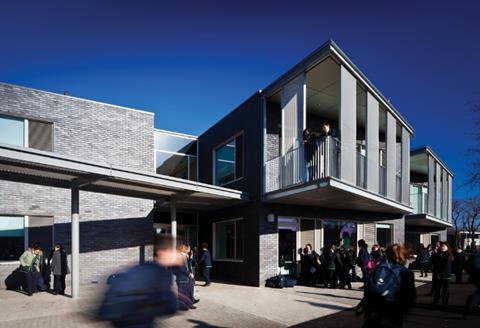
Goldfinger’s legacy
Like Elliott, Haggerston is a product of the post-war school building boom and was constructed between 1962 and 1965 by Erno Goldfinger, an architect with even greater posthumous kudos than the LCC. Like Elliott, Haggerston is also grade II-listed and its architecture exhibits the same quasi-brutalist tendencies that, for most members of the public have fallen out of favour.
Haggerston too had spiralled into a cycle of decline, with its single window glazing and poor building maintenance leading to unacceptable environmental conditions inside the building. Prior to refurbishment, the school was forced to close around three days every term due to being too cold in the winter or too hot in the summer. Its concrete facade was also crumbling and Goldinger’s original hyper-rational site composition had been corrupted by the addition of bland, single-storey, pitched roof, brickwork extensions referred to by the design team as “Burger Kings”.
Avanti’s solution was largely minimalist but highly effective. Goldfinger’s plan had created three main separate but connected blocks. A two-storey entrance annexe contained the assembly hall and some administrative offices. A sports block was located at the far end of the site. And the main teaching building was a rectangular, four-storey, concrete-frame classroom block whose facade was divided into a continuous series of four-window bays. On either side of the building, the composition is broken at one end by a projecting bay featuring larger expanses of full-height glazing.
Avanti director Amir Ramezani summarises the design approach as “minimal intervention to the set-piece areas, complete refurbishment of the main block, removal of insensitive additions, a new-build technology annexe and the introduction of a new way-finding and orientation strategy throughout the school”. The tight budget also forced the team to be judicious about where money was spent.

Consequently the sports and entrance blocks remain largely untouched, although in the former, new windows will be fitted in a future phase and a new lift has been squeezed beside the tight entrance staircase to ensure compliance with the Disability Discrimination Act.
The entrance annexe has also been cosmetically refurbished and new offices and a reception area have been installed. But many of Goldinger’s original details, such as the recessed wall pockets for opened doors and the exposed waffle slab to the double-height lobby, have been retained and restored.
It is in the main block that most of the intervention takes place. The poor conditions in teaching areas were identified as the chief design obstacle early in the project and this has been addressed by the replacement of all the original single-glazed steel windows with new high-performance thermally broken powder-coated aluminium windows.
Moreover, where only half the building’s windows were previously openable, now they all are, thus providing improved levels of natural ventilation. Window profiles were agreed with English Heritage to meet conservation standards and the external concrete has also been repainted.
Poor orientation within the school was also identified as a major problem and various design measures have been adopted to counteract this. A new double-height entrance lobby has been carved into the main block which also includes direct ramped access to the playground beyond - previously only accessible via a staircase.
The spinal corridor that runs through the centre of the block on all floors has also been widened at key locations to create break-out spaces and broad alcoves that introduce variety into the floorplan. And extensive use has been made of colour, with each floor themed to a different tone.
While this is not an uncommon visual strategy in contemporary school and healthcare design, its implementation is uniquely suited to Haggerston’s architecture. The corridors within the school are long shafts lined by the concrete columns of the structural frame on either side. By using various shades of the same colour in vertical strips of varying width, the regimentation of the corridors is eased as the columns dissolve into a patterned background.
But even within the main block, the overriding theme has still been one of sensitive rather than radical intervention. Little beyond cosmetic redecoration has been applied to the staircases, whose broad treads and continuous stainless steel guardrail grille already exude more than sufficient institutional practicality.
Apart from the installation of new radiators, the services configuration has also been left largely untouched, with a key early decision leaving the most highly serviced area, the kitchen, in the same place. And suspended ceilings have been removed to reveal the original, rather rough-hewn concrete beams, whose newly exposed thermal mass now helps to cool the building at night.
The new boy
The new technology annexe represents the boldest new architectural gesture on the site. This charming little two-storey pavilion is clad in blue-grey semi-engineering brickwork to match that of the caretaker’s house next door rather than the concrete of the main block.

The pavilion’s architecture is a clever volumetric inversion of the main block. While the latter is solid, cubical and institutional, the pavilion is configured as a terrace of perforated, chamfered, domesticated boxes all aligned to a new diagonal axis and punctuated by large, protruding semi-enclosed balconies. It is a dynamic and expressive little building, deftly employing scale and intimacy to humanise the site and subtly acting as a foil and a frame to the monotonous massing of the main building.
The pavilion was also a key feature of the enabling works required while construction was taking place, during which time the school remained in continuous use. The main school block was refurbished in phased vertical stacks, a strategy encouraged by the configuration of its structural frame, and one which expelled the least noise disruption into the remainder of the school. The technology department was able to decant into the new pavilion, thus enabling other departments to occupy their refurbished former accommodation while construction progressed.
Haggerston school is not Goldinger’s best work. The main block elevations in particular exhibit the same dreary pugilistic repetition that scarred so much sixties public architecture. Goldinger’s signature flourishes are few and far between, although all the more welcome for their scarcity. These include the sculpturally cast spiral concrete staircase that pirouettes from the first floor of the entrance annexe and the soaring water tower shaft that provides much-needed dramatic relief to the lugubrious roofline.
But Avanti’s approach has been a clever one. It has left in place what is good about Goldfinger’s work, such as the idiosyncratic detailing and the rugged, robust internal materials. But it has also introduced a series of environmental and design retrofit solutions that are marked by a passive pragmatism that has been effective and economical. To thoroughly modernise a school as well as provide a new building on the same site with such a limited budget is impressive indeed.
Ramezani himself admits that the limited budget forced “a more disciplined and rigorous design approach where priorities had to be carefully balanced between conservation, refurbishment and new-build in a dynamic way.” The double-height lobby of the new pavilion, where the installation of a removable fire curtain in the first-floor slab zone negated the expensive installation of sprinklers, is a perfect example of the cost-effective strategies that have now convincingly extended the lifespan of a formerly drab sixties comprehensive.
Could this approach work elsewhere? Ramezani is convinced it can. “School buildings like Elliott may be composed of a finer grain with more expanses of curtain walling but, fundamentally, the problems as well as the design solutions are the same.”
But the arguments for and against these buildings is driven as much by politics as design, and the sacrificial slaughter of sixties concrete buildings remains a popular, if divisive form of aesthetic cleansing. While residents of the Alison and Peter Smithson designed Robin Hood Gardens estate have repeatedly made clear their preference for demolition, a coterie of often Georgian townhouse-dwelling architects fiercely campaigns its their survival. And the demolition of John Bancroft’s groundbreaking Pimlico school, a contemporary of both Haggerston and Elliott, provoked commendation and condemnation in roughly equal measure.
If you are morally offended by brutalist architecture, then no amount of bright paintwork or double glazing is likely to change your mind. But if aesthetic prejudice is laid to one side for a moment and the feasibility of retaining these buildings is coldly assessed in economic, environmental, and accommodation terms, then Haggerston proves conclusively that refurbishment is a solution that deserves equal consideration.
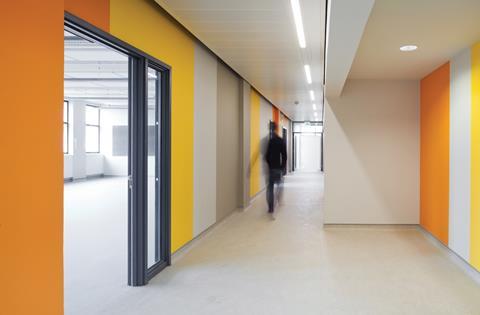
PROJECT TEAM
client Hackney Local Education partnership/ Mouchel Babcock Education
architect Avanti Architects
contractor Willmott Dixon
structural engineer Liverpool 20:20
M&E engineer Mouchel
quantity surveyor Cyril Sweett
In contrast … the controversial case of Elliott School


Elliott school, in south-west London’s Putney, hit the national headlines this summer when it emerged that it was one of five schools which Michael Gove, the education secretary, had approved the sale of land despite opposition from his advisory body, the School Playing Fields Panel.
The approved plans, drawn up by Hawkins Brown and Lend Lease, involve demolition of the listed gym. Estimates for the refurbishment works and a brand new sports hall have been as high as £33.6m, which Wandsworth council says necessitates the sale of 41% of the school’s site.
Elain Harwood of English Heritage described the school as “perhaps the finest of the large comprehensive schools built by the London County Council architects”.
Built in 1955-56, it is ascribed to architect GA Trevett of the London County Council, but architect John Bancroft is also thought to have been on the design team. Bancroft’s most famous building Pimlico school was demolished in 2008.
To read the views of John Bancroft’s widow on the plans for partial demolition on our sister website BDonline click here
Education White Paper






















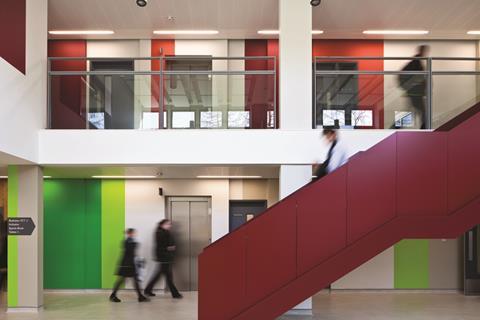
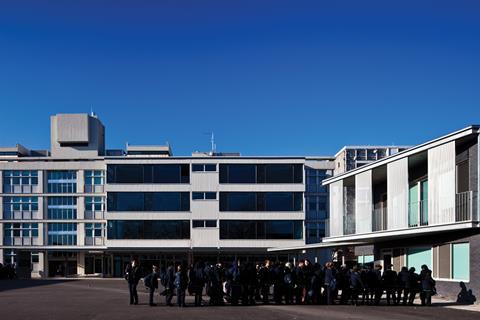
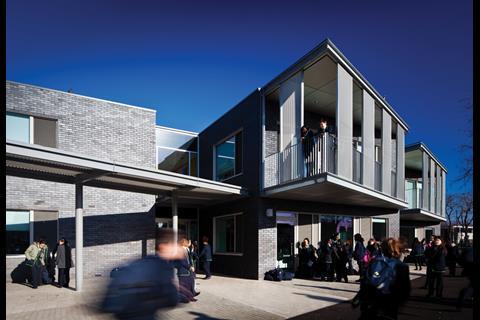
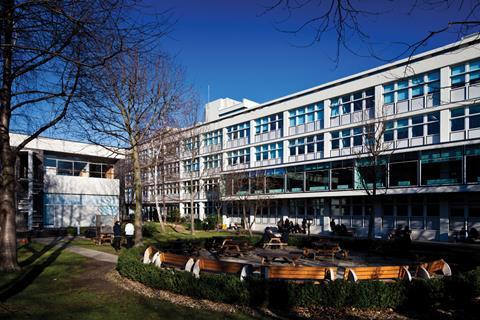
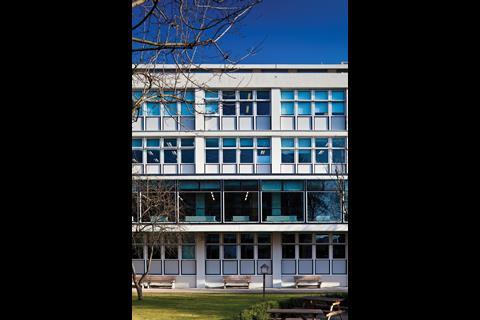
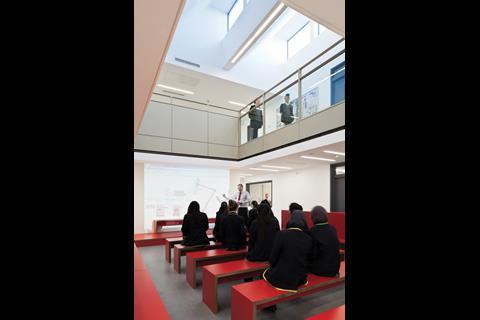
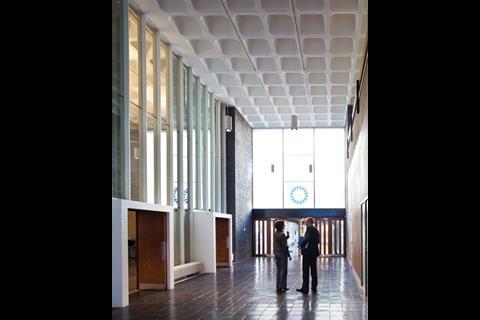


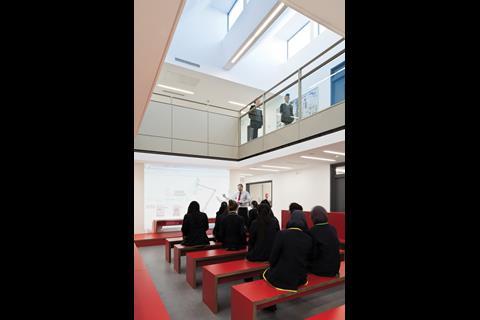







No comments yet